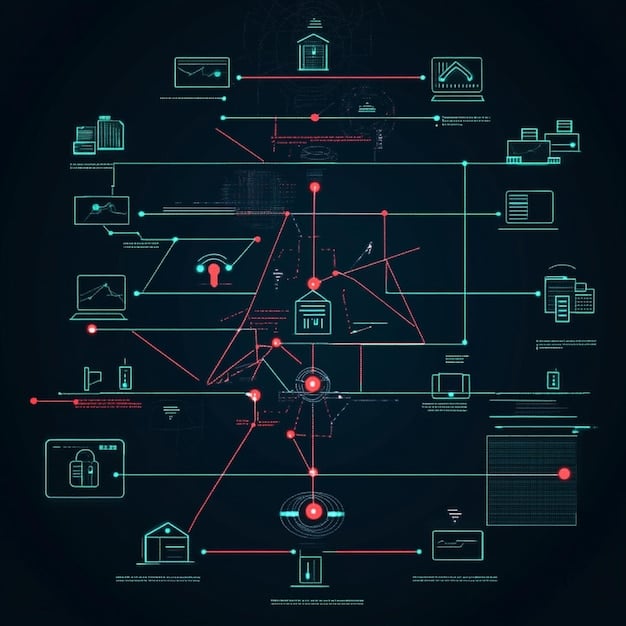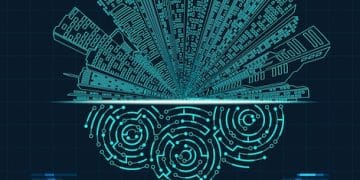AI and Cybersecurity: Defending Against AI’s Dark Side

AI and cybersecurity are intertwined, as malicious actors increasingly leverage AI to launch sophisticated attacks, necessitating robust defenses to protect against these emerging threats.
The rise of artificial intelligence (AI) has brought about revolutionary advancements across various sectors. However, this technological leap also presents new challenges, particularly in the realm of cybersecurity. AI and cybersecurity: protecting against malicious use of AI has become a critical concern as cybercriminals increasingly harness the power of AI to launch more sophisticated and effective attacks.
The Dual-Edged Sword of AI in Cybersecurity
AI’s impact on cybersecurity is complex, offering both opportunities and risks. Understanding these dynamics is crucial for developing effective strategies to mitigate potential threats and leverage AI’s defensive capabilities.
AI as a Threat Amplifier
AI can significantly amplify the scale and sophistication of cyberattacks, making them more difficult to detect and defend against.
- Automated Vulnerability Discovery: AI can scan networks and systems for vulnerabilities much faster and more efficiently than humans, allowing attackers to identify and exploit weaknesses quickly.
- Enhanced Phishing Campaigns: AI can craft highly personalized and convincing phishing emails, making it harder for users to distinguish them from legitimate communications.
- Evasive Malware: AI-powered malware can adapt and evolve to evade detection by traditional antivirus software, making it more persistent and damaging.
AI as a Defensive Tool
Conversely, AI also offers powerful tools for enhancing cybersecurity defenses, providing capabilities that were previously unattainable.
- Threat Detection and Response: AI can analyze vast amounts of data to identify patterns and anomalies that indicate potential threats, enabling security teams to respond more quickly and effectively.
- Automated Security Operations: AI can automate many routine security tasks, such as vulnerability patching and incident response, freeing up human analysts to focus on more complex issues.
- Predictive Security: AI can predict future attacks based on historical data and emerging trends, allowing organizations to proactively strengthen their defenses.
The effective use of AI in cybersecurity requires a proactive and balanced approach, recognizing both its potential benefits and risks. Focusing on responsible development and deployment is key is keeping organizations safe from advanced attacks.

Understanding AI-Driven Cyberattacks
To effectively defend against AI-driven cyberattacks, it’s crucial to understand the specific types of attacks that AI enables and how they differ from traditional methods.
Deepfakes and Social Engineering
AI-generated deepfakes can be used to create convincing fake videos or audio recordings of individuals, which can then be used for social engineering attacks.
Automated Botnets
AI can be used to create botnets that can automatically adapt to changing network conditions and evade detection.
AI-powered botnets can launch more sophisticated distributed denial-of-service (DDoS) attacks, overwhelming targets with massive amounts of traffic and disrupting their services. Moreover, AI can automate the process of identifying and compromising new devices to add to the botnet, making it easier to scale attacks.
Adversarial Machine Learning
This involves manipulating machine learning models to cause them to make incorrect predictions or classifications, which can have serious consequences in security-critical applications.
For example, an attacker could modify images to trick an AI-powered facial recognition system into granting unauthorized access to a secure facility. Defense against adversarial machine learning requires a deep understanding of the vulnerabilities of AI models and the development of robust techniques to detect and mitigate these attacks.
Disrupting these attacks requires a deep understanding of AI’s capabilities and the evolving landscape of cyber threats. Continuous learning and adaptation are vital for staying ahead of malicious actors who constantly refine their tactics.
Building Resilient AI-Powered Defenses
Developing robust defenses against AI-driven attacks requires a multi-layered approach that combines technological solutions, human expertise, and proactive security practices.
AI-Powered Threat Intelligence
Utilize AI to analyze threat data and identify emerging risks and vulnerabilities.
AI can significantly enhance threat intelligence by automating the collection, processing, and analysis of vast amounts of data from diverse sources. It allows organizations to predict adversarial behavior, strengthen defense, and allocate resources to the areas that need it most. This proactive approach enables security teams to stay ahead of emerging threats and minimize potential damage.
Behavioral Analytics
Implement AI-based behavioral analytics to detect anomalous activities that may indicate a cyberattack.
AI excels at identifying deviations from normal behavior patterns, which can be a strong indicator of malicious activity. By continuously monitoring user and system behavior, AI can detect anomalies that would be difficult or impossible for humans to spot, such as unusual login patterns, unauthorized data access, or suspicious network traffic. Rapid detection allows for timely incident response and minimizes the impact of attacks.

Ethical Considerations and Governance
The use of AI in cybersecurity raises important ethical considerations that must be addressed to ensure responsible and trustworthy deployment.
Bias in AI Systems
AI systems can inherit biases from the data they are trained on, leading to unfair or discriminatory outcomes.
In cybersecurity, biased AI systems could disproportionately flag certain user groups as high-risk or fail to detect attacks targeting specific populations. Addressing bias requires careful attention to data collection, model design, and ongoing monitoring to ensure fairness and equity. Implementing diverse data sets and transparent algorithms is important to mitigate the risk.
Transparency and Explainability
It is essential to understand how AI systems make decisions to ensure accountability and build trust.
Many AI algorithms, particularly deep learning models, are “black boxes” that are difficult to interpret. Promoting transparency and explainability in AI systems is crucial for enabling security teams to understand and validate their decisions. Explainable AI (XAI) techniques can provide insights into the factors driving AI-powered security tools, which helps build confidence in their effectiveness and mitigates associated risks.
Privacy Considerations
AI systems often require access to vast amounts of data, which can raise privacy concerns.
In cybersecurity, it is important to implement robust data protection measures and ensure that AI systems comply with privacy regulations. Anonymization techniques, data minimization strategies, and privacy-enhancing technologies can help mitigate these risks. Striking a balance between data utility and privacy is important for maintaining public trust and enabling the responsible use of AI in cybersecurity.
These ethical consideratons have to be adressed to ensure that AI technologies are responsible and beneficial for all stakeholders.
The Future of AI and Cybersecurity
The intersection of AI and cybersecurity will continue to evolve rapidly in the coming years. Adapting to these changes and proactively addressing the challenges and opportunities is essential for maintaining a strong security posture.
Quantum-Resistant AI
Develop AI algorithms that are resistant to attacks from quantum computers.
The development of quantum computers poses a significant threat to many existing cryptographic algorithms, which could undermine the security of AI systems. Quantum-resistant AI algorithms are needed to protect AI models and data from quantum attacks. These algorithms, designed to withstand the computational power of quantum computers, will likely become an essential component of security infrastructure to maintain the confidentiality and integrity of AI systems.
Collaboration Between Humans and AI
Foster collaboration between human security analysts and AI-powered systems for optimal threat detection and response.
AI can automate many routine security tasks and provide valuable insights, but human analysts remain indispensable for handling complex and nuanced threats. Hybrid security models that combine the strengths of both humans and AI can lead to more effective threat detection, incident response, and overall security management. This collaboration also provides opportunities for ongoing learning and refinement of AI systems.
Implementing a Proactive AI Security Strategy
Protecting your organization from malicious AI requires a forward-thinking strategy. By implementing these important measures, you can make sure your systems are secure and resilient.
Regular Security Audits
Conduct frequent audits to check for vulnerabilities and make sure your protective equipment is secure and reliable.
Regular Security Audits are highly effective when assessing the overall security posture of the organization and identify current weak spot within the environment. Regular Audits are key for identifying vulnerabilities that could be exploited, allowing the business to stay compliant with all applicable regulation and provide insights into possible risks and improvements.
Training and Education
Develop employee training programs to educate them about the risks and methods used in AI-related cyberattacks, such as phishing and deepfake schemes.
Investing in employee training and education is an effective measure to create a culture of cyber security awareness across the organization. Employees equipped with knowledge on how to identify and report cyber threats, will minimize the human error and mitigate the risk associated to security breaches. Trainings should be up-to-date and relevant based on the industry to ensure that the employees are able to adapt based on the ongoing circumstances.
| Key Point | Brief Description |
|---|---|
| 🛡️ AI-Enhanced Threats | AI amplifies attack scale, sophistication, and automation. |
| 🤖 Defenses with AI | Use AI for threat detection, automation, and predictive security. |
| 💡 Addressing Ethics | Address biases, ensure transparency, and protect data privacy. |
| 🔮 Future-Proofing | Prepare for quantum-resistant AI and human-AI collaboration. |
Frequently Asked Questions (FAQ)
AI enhances cyber threats through automated vulnerability discovery, creating more convincing phishing campaigns, and developing evolving, evasive malware that avoids traditional detection methods.
AI tools improve cybersecurity by enhancing threat detection and response, automating security operations, and enabling predictive security, allowing companies to anticipate and mitigate future attacks.
Ethical considerations include addressing biases in AI systems, ensuring transparency and explainability in decision-making, and adhering to strict data privacy protocols to protect user information.
Companies can prepare by developing quantum-resistant AI, fostering collaboration between human security analysts and AI systems, and implementing proactive strategies like security audits and employee training.
Strategies include continuously updating threat intelligence, employing behavioral analytics to detect anomalies, and regularly auditing security measures to ensure they remain effective and protect against evolving threats.
Conclusion
In conclusion, the integration of AI into cybersecurity presents both significant challenges and opportunities. By understanding the dual-edged nature of AI, building resilient defenses, addressing ethical considerations, and implementing proactive security measures, organizations can effectively protect themselves against malicious AI and harness its power for good. It is crucial to stay informed and adapt to the rapidly evolving landscape to maintain a strong security posture in an increasingly intelligent threat environment.





